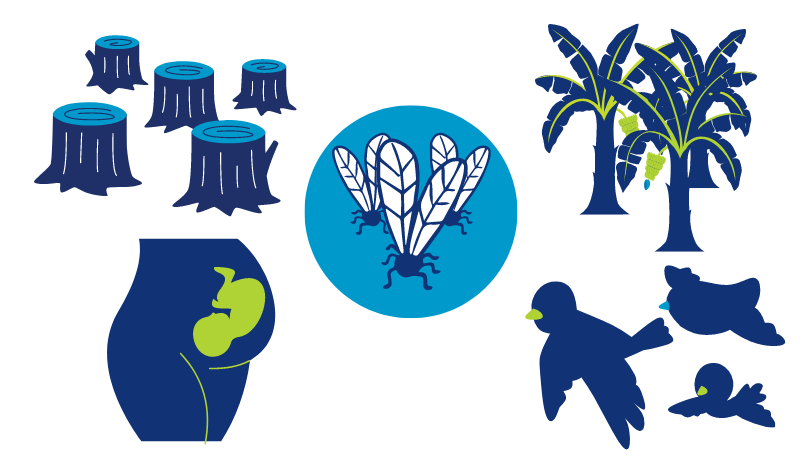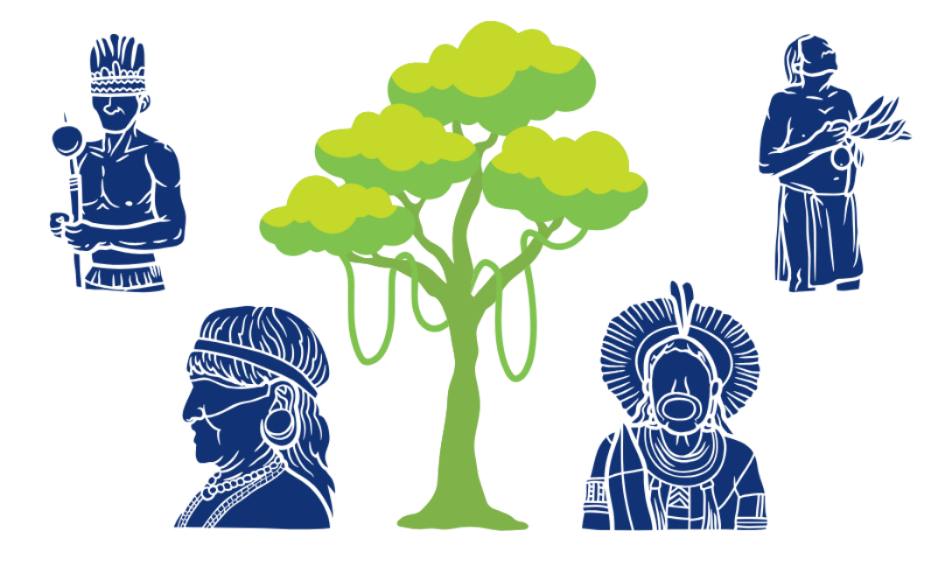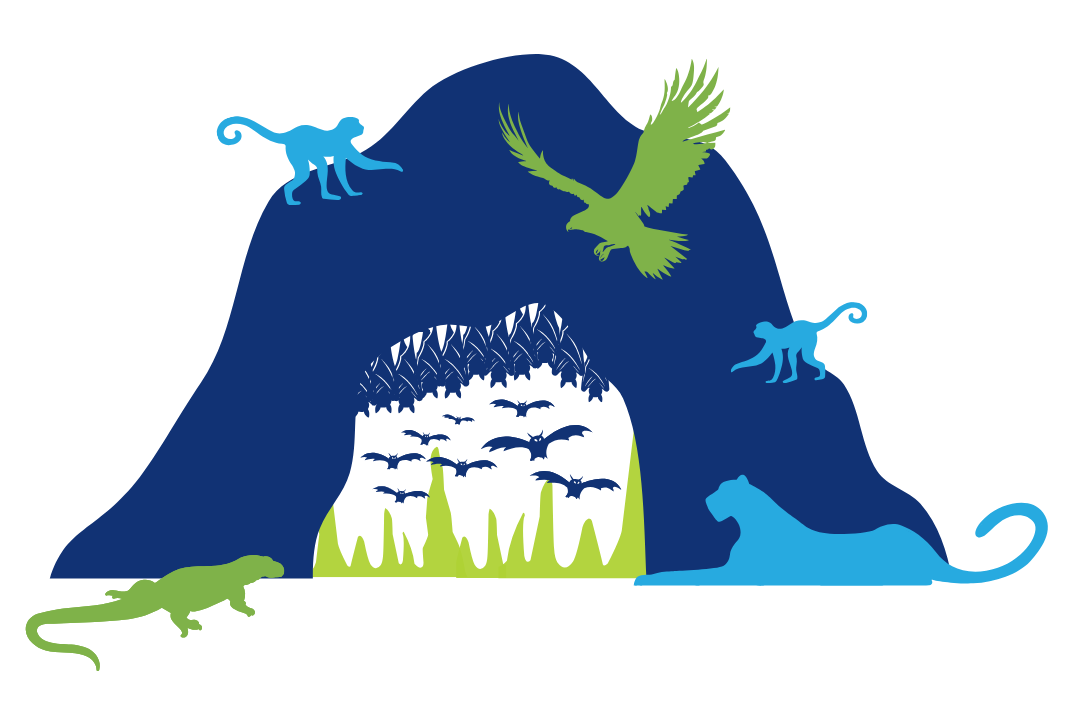
Farmers need land to grow their crops, and in many parts of the world, that means clearing forests. That’s especially true in the Amazon region in South America. Crops just won’t grow under the thick forest canopy, so a new banana plantation means clearing trees. This has all sorts of effects on the ecosystem and researchers are seeing a new one.
A virus called Oropouche was identified back in the 1950s, but it was pretty rare. Like so many viruses, it causes headaches, body aches, fever, and other unpleasant symptoms. What’s most unusual about Oropouche is that it’s most often carried by midges – small, biting flies, more difficult to see than mosquitoes. All of a sudden, Oropouche has started spreading and infecting more people than ever before and it has been detected in new countries. The virus has also started to kill people in Brazil and there’s some evidence it may affect the fetuses of pregnant women.
So what’s going on? Dr. Daniel Romero-Alvarez has an idea. He’s found Oropouche appears in places where forests have been cleared. The change in land use may be making new and better places for the midges that spread the virus to breed, he says. “Midges loves banana and cocoa plantations,” adds Romero-Alvarez, a medical doctor and epidemiologist at Universidad Internacional SEK in Quito, Ecuador. And the movement of humans and other animals that can carry this virus means that we may be hearing more about Oropouche in the future. Listen as he tells One World, One Health what he’s learned about this once-rare virus.
Maggie Fox 00:00
Hello and welcome to One World, One Health where we chat with people working to solve the biggest problems facing our world. I am Maggie Fox. This podcast is brought to you by the One Health Trust with bite-sized insights into ways to help address challenges, such as infectious diseases, climate change, and pollution. We take a One Health approach that recognizes that we are all in this together and everything on this planet — the animals, plants, and people, and the climate and environment — are all linked.
Just as you might have hoped, we were all through hearing about unusual viruses, now we are starting to hear about Oropouche virus. It is not exactly a new virus, but it has been spreading more widely than seen before in Brazil and elsewhere in South America, and it has shown up in Cuba for the first time. Mosquitoes can carry it, but unlike many, these viruses are spread mostly by little flying insects called midges.
Oropouche causes fever, headaches, chills, achiness, and nausea, and can sometimes lead to inflammation of the brain or spinal cord, serious symptoms called encephalitis or meningitis. That is when Oropouche can kill people. Brazil reported two people died from Oropouche in July. The virus has been diagnosed in travelers coming home to the US, Germany, Spain, and Italy.
So, what is causing the surge? Dr. Daniel Romero-Alvarez, an epidemiologist at International University SEC based in Quito Ecuador, says there’s evidence, that shows it has something to do with the loss of forests. He is joining us to discuss the virus and what might be helping it spread.
Daniel, thank you for joining us.
Daniel Romero-Alvarez 01:41
Thank you very much for having me here. I am super happy to participate.
Maggie Fox 01:44
So first off, can you tell us a little bit about the Oropouche virus?
Daniel Romero-Alvarez 01:51
Yes, so this is a super curious virus that has been circulating in South America for a long time. It was first discovered in 1955 in a patient in Trinidad and Tobago. Since then, multiple outbreaks have been recorded in different countries, especially in Brazil. But then it started to be discovered in Peru, Colombia, and other regions (where it was not seen before), causing the 2024 outbreak, which is super huge.
Maggie Fox 02:18
This virus, although it’s been found in mosquitoes, is not spread necessarily by mosquitoes, but by these little flies called midges.
Daniel Romero-Alvarez 02:28
That is the most important factor. So, the insect that is transmitting the disease, which is Oropouche fever, is a midge that is called Culicoides paraensis. It is a midge, not a mosquito. This is an interesting differentiation, because when you think of insects transmitting diseases, you usually think of mosquitoes, right?
The classic one (we think) is Aedes aegypti, the one that transmits dengue. But there are pictures anyone can find online that compare a mosquito with a midge. A mosquito is giant in comparison to the very small size of a midge. This (understanding) is important because it is far more difficult to be aware of a very small insect biting you. A mosquito is a big insect, it is big enough to get spotted, so you can either kill it or drive it away from you.
Maggie Fox 03:16
You say that cutting down forests and the vast deforestation that is happening in South America could be helping it (Oropouche virus) spread. How does that happen?
Daniel Romero-Alvarez 03:27
My research has found that areas, where we have lost vegetation, are related to human outbreaks of Oropouche fever. This is an important detail to mention because the way we measure the loss of vegetation is through satellite images. So, we download images from satellites and then compare vegetation, more or less before and after the appearance of Oropouche outbreaks. We found that areas with higher Oropouche fever cases had less vegetation compared to other regions.
We consistently found this (pattern) in an outbreak that happened in Peru in 2016. It was the first time I heard about Oropouche virus and then we found the same pattern across 35 outbreaks that happened up till 2019. Areas with loss of vegetation have more probable Oropouche fever cases than other areas. We have tested that in my research and found this correlation between loss of vegetation and Oropouche virus outbreaks. So, more studies are needed to confirm this theory, and this is crucial.
Why are we not doing this study on-site?
Being from Ecuador, I can say that there have not been many detected cases of Oropouche fever here.
I believe that is because we are not doing full surveillance of the virus in Ecuador. Currently, the reason so many cases are being detected in Brazil is that they are actively looking for them, as they are aware of the potential epidemic. According to my research, the virus has been circulating in South America for a very long time, and we have not detected the virus because we are not looking for it.
Other viruses in the region are also overlooked because we are fully focused on dengue. Also, the way we study infectious diseases is reactive. For instance, we often encounter unusual cases of patients with fever, but we do not understand the cause of that fever. So, we do not say “Okay let us investigate beyond the usual suspects like dengue.” This is a reactive way to look for pathogens.
But pathogens are part of the ecosystem. We do not usually capture mosquitoes or midges and see what they have. “Do they have any virus that can potentially harm humans?” So, the way we survey infectious diseases is reactive.
Maggie Fox 06:01
Just to clarify, you are not starting with the assumption that cutting down forests must be bad, and so now we are going to look for proof it is bad and prove that it spreads the virus. Instead, you first saw that the virus was spreading in places where the forests had already been cut down.
Daniel Romero-Alvarez 06:19
Yes exactly! We found that outbreaks of Oropouche fever were detected in places where the vegetation was lost. There is a reason this might be happening.
Once the trees are taken down, the empty area is used for agricultural purposes, and there is anecdotal evidence showing that the vector the midge, Culicoides paraensis loves to reproduce and live happily in banana and cocoa plantations.
Maggie Fox 06:48
Now this might be counterintuitive to some people because you might think there would be more insects in a forest, not fewer. What is it about a banana plantation that makes it such a suitable place for midges?
Daniel Romero-Alvarez 07:01
Theoretically, if you have more forests, you will have more insects. True. But to answer that question, you must understand that there is this concept of not only insects but also for other kinds of animals and plants that prefer to live in ecosystems that are not forested.
Like for example, Aedes aegypti and urban environments. These mosquitoes prefer to live in urban centers, so they have adapted to consuming blood from humans and other animals. The same might be happening with Culicoides paraensis, that insect, prefers to live in banana plantations rather than in forests and that is it.
Maggie Fox 07:41
Aedes aegypti is the mosquito that spreads many bad diseases we have heard about, like Dengue fever and Zika.
Daniel Romero-Alvarez 07:51
Something interesting about dengue is that it can be very severe and bad in some contexts, but not necessarily in all contexts. I am saying this because one reason the Oropouche virus or other obscure viruses are not being studied yet is because, in theory, they are not very lethal.
That is another reason we are not aware of all the pathogens that have the potential to affect humans. It is because we do not see them as lethal. There is another virus circulating across South America — the Mayaro virus, this virus is like Oropouche virus. It is not extremely dangerous, so that is why we are not studying it at all. Potentially, we will start studying it after the next epidemic.
Maggie Fox 08:33
One of those viruses that people did not pay attention to for many years was Zika. Now, of course, there’s evidence that, like Zika, Oropouche viruses can cause birth defects if a woman gets infected while she is pregnant.
Daniel Romero-Alvarez 08:45
Yes, to take on that argument. The first is that we knew previously that Oropouche virus was able to cause birth defects, so it was not a surprise to find birth defects in the current epidemic. What is more significant is that since the virus was first identified in 1955, this is the first time the Brazilian Ministry of Health has reported deaths caused by Oropouche virus. This means people have died from this virus for the first time in recorded history.
I know this because some unofficial reports have been circulated online, and that were confirmed by the Ministry of Health, but the details on how these people died was not shared. The only information I have is that the two individuals who died from the Oropouche virus were women under the age of 35. Understanding why they succumbed to the virus will be crucial in predicting the potential course of the epidemic in the coming months.
Maggie Fox 09:46
So however, like many viruses, Oropouche virus can cause meningitis, and encephalitis, and those can, of course, both be deadly.
Daniel Romero-Alvarez 09:55
Yes, Oropouche virus can cause meningitis and encephalitis, but the number of people affected by these severe conditions is extremely small. That is why, for example, while Oropouche fever cases are being reported during the current epidemic, there have not been many reports of people with benign encephalitis. Most people are only familiar with the classic presentation of Oropouche fever.
Maggie Fox 10:20
So, is there a lesson to be learned from this? People are cutting down forests to farm, but this might be releasing these midges that can then spread this virus. What can people do about this problem?
Daniel Romero-Alvarez 10:31
That is a particularly challenging question, because, in the end, in many places, the reason people use the forest areas is because they need the land to cultivate the food to eat, earn some income, and survive.
The advice to stop cutting the forest is challenging. So, something that people can do if they are in this situation, they can try applying some strategies to avoid the breeding of midges, just using repellent, trying to use clothes that cover a lot of the skin, and trying to avoid endemic areas where active transmission is occurring. This is an important recommendation for identifying areas of active transmission.
During the Zika epidemic, something notable occurred: the CDC implemented a prevention strategy as part of their response — to avoid all areas below 2000 meters above sea level, and put together a map showing which areas are above that area. They were saying, “You should not go anywhere!” It was such a counterintuitive prevention strategy. So first determine where an active area of transmission is and then avoid it, because there is no vaccine against Oropouche.
Maggie Fox 11:42
Right now, there is no vaccine against oral push, and there is no treatment for it
Daniel Romero-Alvarez 11:48
As a viral disease, the treatment primarily focuses on managing symptoms, such as reducing fever, relieving pain, and ensuring rest. Since this virus has never been thoroughly studied, there is currently no vaccine available.
Maggie Fox 12:05
These midges are not flying from Brazil to Cuba. Something is carrying the virus, and that something might be people.
Daniel Romero-Alvarez 12:13
Yes, and despite insects migrating to other areas, it is important to note that there are many many species of midges. The one known to actively transmit the Oropouche virus is Culicoides paraensis. But there are multiple other species. So, if a person infected with the virus travels to another country, the biggest risk is that a local vector in that country could acquire the virus and establish endemic transmission, and that is the most problematic and worrisome factor on how these viruses can spread to other areas.
Maggie Fox 12:55
The perfect example of that was the West Nile virus, in right Western Hemisphere. West Nile did not exist in the Western Hemisphere till the beginning of the 2000s when somebody carried it. It can now be found even in Kansas and California.
Daniel Romero-Alvarez 13:11
Exactly, and there are multiple examples of that, right? The Chikungunya virus was not found in America. It was a disease from Africa. That is why they use the word chikungunya (in the Kimakonde language of Africa) but then it was discovered here because of the way these arboviruses are spreading.
Maggie Fox 13:27
So that is why everybody must be worried about deforestation in Brazil.
Daniel Romero-Alvarez 13:33
Yes, and not only because of Oropouche virus. We are using this particular case to understand how areas with vegetation loss become breeding grounds for Culicoides, causing Oropouche virus outbreaks. When deforestation occurs, the ecosystem changes, creating conditions that encourage species that thrive near deforested areas to proliferate, driving the spread of the virus. And species such as rodents are important species that live in forested areas, they love to be in touch with humans, and, of course, urban centers.
That is why deforestation has also been linked with Lyme disease, which is another important infectious disease in the US. And there is this topic about the “dilution effect”.
when you reduce the diversity of species in a forest by eliminating the forest, many species that depend on trees will no longer survive. As a result, species that can thrive outside forested areas, like rodents, will proliferate. Ixodes (black-legged ticks) are key for the life cycle of Lyme disease.
It is important to talk about the case of Culex quinquefasciatus as a vector of Oropouche virus. Culex is not a midge. It is a mosquito. This is important to mention because there is controversial evidence of the role of Culex quinquefasciatus in transmitting Oropouche virus.
There is an experiment done in Florida, not in conditions outside the laboratory, but in a laboratory. They demonstrated that Culex quinquefasciatus might not be the best vector. However, there have been detections of the Culex quinquefasciatus, spreading Oropouche virus. So, if we use protective clothes and repellent and try to avoid mosquitoes, that helps. not only for Oropouche virus, but for a lot of diseases, and because we do not know what mosquitoes might carry, (it is important that) we protect ourselves.
Maggie Fox 15:34
Tell me if I am wrong, but that little Culex mosquito, it’s everywhere, and isn’t that one of those that bite birds and spread diseases to birds too?
Daniel Romero-Alvarez 15:42
Yes, that mosquito is everywhere. I have a publication with some colleagues from Los Alamos National Laboratory, in New Mexico where we updated the distribution of Culex mosquitoes in America. Not only quinquefasciatus , but a lot of other species as well. And we found that they are everywhere, and not only in America. So, they are good transmitters of diseases as well.
Maggie Fox 16:04
Of course, I think they played a role in establishing the endemicity of West Nile. If I am not wrong?
Daniel Romero-Alvarez 16:11
Yes! They did transmit West Nile.
Maggie Fox 16:15
They infected birds, and then birds became the reservoirs, and that’s how West Nile spread everywhere. So, if this Oropouche virus can be spread by Culex mosquitoes, we could be in trouble.
Daniel Romero-Alvarez 16:27
Yes, and something important is that, as you correctly mentioned, right, birds, mammals, let us not forget that we as humans are mammals as well. So, mosquitoes are not going to see us as, oh, humans, let us respect them. We are mammals for them, and as such, we are in this ecosystem, and we are all connected. So we have to be aware of how pathogens are also part of our ecosystems, and of course, of our daily lives.
Maggie Fox 16:53
Daniel, thank you so much for joining us.
Daniel Romero-Alvarez 16:55
Thank you very much.
Maggie Fox 16:56
Listeners. If you enjoyed this podcast, please share it. You can learn more about this podcast and other important topics at onehealthtrust.org and let us know what else you would like to hear about at [email protected]. Thanks for joining us.
Guest

Dr. Daniel Romero-Alvarez is a medical doctor (MD) and doctor of philosophy (PhD) in the Ecology of Infectious Diseases, working as an associate professor at the Universidad Internacional SEK, Quito, Ecuador. His research crosses multiple disciplines and sectors from molecular diagnosis of zoonotic bacteria (e.g., leprosy in armadillos) to distributional ecology of diseases such as anthrax or Oropouche fever. Daniel is interested in wildlife and zoonotic diseases, open access, and scientific outreach. Check out his personal website to follow his research initiatives and resources in Spanish and English on his website: www.romerostories.com
Credits
Hosted and written by Maggie Fox
Special guest: Daniel Romero-Alvarez
Produced and edited by Samantha Serrano
Music composed and sound edited by Raquel Krügel







